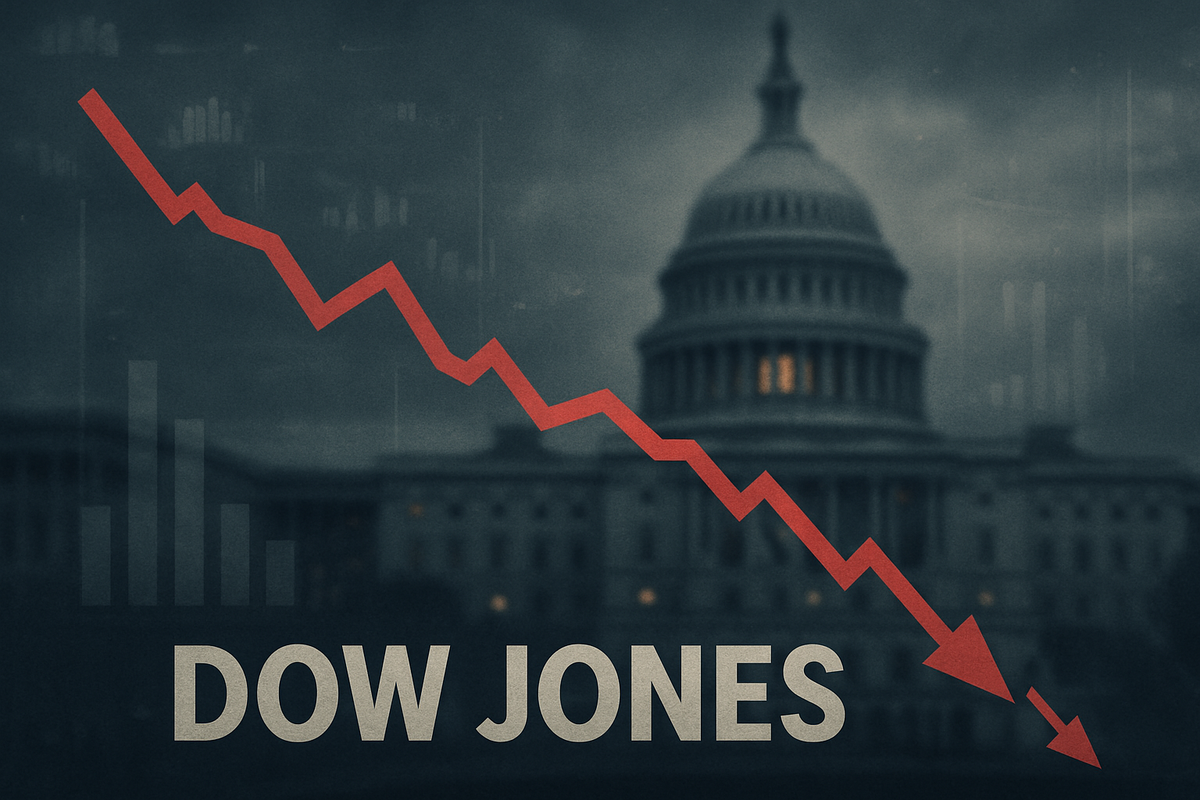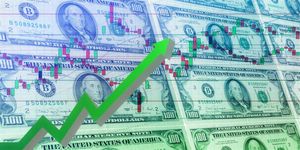
The Dow Jones Industrial Average (DJIA) experienced a notable slide today, October 9, 2025, as a confluence of a U.S. government shutdown, mounting economic concerns, and specific corporate disappointments sent ripples of apprehension through the financial markets. This downturn signals a renewed period of volatility, challenging investor confidence and prompting a re-evaluation of current market stability.
The immediate implications are a heightened sense of uncertainty across various sectors, with investors grappling with the dual pressures of political gridlock and softening economic indicators. While the full extent of the slide's impact is yet to unfold, market participants are bracing for potential further corrections and a possible shift in investment strategies as they navigate this complex landscape.
Unpacking the Market's Retreat: A Day of Converging Pressures
Today's decline in the DJIA was not a singular event but rather the culmination of several significant factors. Primarily, the ongoing U.S. government shutdown, now extending into its ninth day, has cast a long shadow over the market. The lack of progress in the Senate regarding funding bills, fueled by partisan divisions over national healthcare provisions, has created an environment of political instability. This shutdown has also critically paused the release of federal economic data, forcing markets to rely more heavily on private sector reports and contributing to a sense of "flying blind" among investors.
Compounding the political woes are a series of concerning economic indicators. Reports suggest a slowdown in job growth, as evidenced by recent private payroll data, leading to fears that reduced consumer spending could impact corporate profits. Furthermore, persistent inflation concerns, stemming from heavy government spending and burgeoning fiscal deficits, continue to fuel anxieties about long-term economic stability. The Federal Reserve's stance has also added to the uncertainty, with Chair Jerome Powell reportedly offering no new guidance on the economic outlook or monetary policy today, leaving investors without clear direction on potential interest rate adjustments.
Specific corporate news also played a significant role in today's market retreat. Luxury automaker Ferrari (NYSE: RACE) saw its shares sink following the announcement of underwhelming long-term financial targets. Banking giant HSBC (NYSE: HSBC) experienced a drop after revealing plans to buy out minority shareholders in its Hang Seng Bank subsidiary. Energy major Chevron (NYSE: CVX) took a hit as oil futures fell, reflecting broader concerns about global energy demand. Additionally, Johnson & Johnson (NYSE: JNJ) was noted for appealing a substantial $966 million settlement related to talc baby powder allegations. This array of corporate-specific headwinds, alongside broader weakness in energy and industrial stocks, underscored a challenging day across various market segments.
Winners and Losers in a Shifting Market
The current market environment, characterized by a DJIA slide, government shutdown, and recessionary fears, is creating a clear divide between potential winners and losers. Sectors sensitive to economic cycles are likely to face significant pressure, while defensive industries may offer a degree of resilience.
Companies in the luxury goods and automotive sectors, such as Ferrari (NYSE: RACE), are particularly vulnerable. As consumer discretionary spending tightens during economic downturns, high-cost, non-essential purchases are often the first to be cut. Ferrari's recent underwhelming long-term financial targets only exacerbate this sensitivity, positioning it as a significant potential loser. Similarly, the financial services sector, exemplified by HSBC (NYSE: HSBC), is often at the epicenter of economic turbulence. Banks are highly sensitive to interest rates, credit demand, and loan defaults. A downturn typically leads to reduced lending, increased defaults, and tighter credit standards, all of which negatively impact profitability.
The energy sector, including integrated giants like Chevron (NYSE: CVX), is also highly cyclical. A global economic slowdown directly translates to decreased demand for oil and gas, leading to falling commodity prices and reduced profitability for producers. Beyond these specific companies, broader losing sectors would include Consumer Discretionary (e.g., airlines like American Airlines (NASDAQ: AAL) and Delta Air Lines (NYSE: DAL), hospitality companies like Marriott International (NASDAQ: MAR)), Industrials (e.g., General Electric (NYSE: GE), Caterpillar (NYSE: CAT)), and Real Estate/Construction (e.g., Home Depot (NYSE: HD)), all of which suffer from reduced consumer and business spending.
Conversely, defensive sectors are expected to show greater resilience. Healthcare, represented by companies like Johnson & Johnson (NYSE: JNJ), typically maintains stable demand for its products and services regardless of economic conditions. While specific legal challenges might impact J&J, the overall defensive nature of its pharmaceutical and medical device businesses provides a buffer against broader market declines. Other resilient sectors include Consumer Staples (e.g., Procter & Gamble (NYSE: PG), Coca-Cola (NYSE: KO), Walmart (NYSE: WMT)), which provide essential goods, and Utilities (e.g., Duke Energy (NYSE: DUK), NextEra Energy (NYSE: NEE)), which offer stable demand and regulated pricing. Discount retailers like Dollar General (NYSE: DG) and Dollar Tree (NASDAQ: DLTR) could also see increased traffic as consumers seek more affordable options.
Broader Implications and Historical Context
The DJIA's slide today, driven by a trifecta of political gridlock, economic anxiety, and corporate specific issues, carries wider significance for the financial ecosystem. It underscores the interconnectedness of political stability, macroeconomic health, and corporate performance, reminding investors that no single factor operates in isolation.
The government shutdown, while historically having a muted long-term impact on the S&P 500, can cause short-term volatility and, crucially, blind policymakers and investors by halting the release of vital economic data. This data vacuum exacerbates market anxiety, making informed decisions more challenging. When combined with underlying economic concerns like persistent inflation and the specter of higher interest rates, the market's vulnerability becomes pronounced. Fears of a recession, fueled by warnings from top financial executives, can trigger a broad-based decline as investors anticipate weaker corporate earnings and consumer spending. Moreover, concerns about elevated stock valuations, particularly in high-growth sectors like technology and artificial intelligence, suggest that a correction might be a necessary market reset, unwinding what some perceive as an "AI-driven bubble."
Such a downturn is likely to accelerate existing industry trends. There will be a discernible shift of capital from speculative growth stocks towards more defensive sectors, as investors prioritize stability and consistent earnings. Companies with high debt loads and those heavily reliant on discretionary spending will face increased scrutiny, leading to a renewed focus on profitability and sustainable business models. The AI sector, despite its immense potential, could face increased scrutiny, compelling companies to prioritize essential infrastructure over speculative applications. The ripple effects could be substantial, impacting supply chains, making fundraising more challenging for startups, and potentially triggering a global de-risking event.
Historically, market slides driven by a combination of government actions and economic concerns are not unprecedented. While individual government shutdowns often lead to short-term volatility, significant budget disagreements, like the 2011 debt ceiling fight, have led to more substantial market corrections. Economic crises, such as the 2008 financial crisis or the COVID-19 pandemic, demonstrate how widespread economic concerns can trigger sharp market declines. The dot-com bubble burst of 1999-2000 also serves as a stark reminder of the unwinding of speculative valuations in high-growth sectors. These precedents suggest that while the current slide is concerning, market corrections, though painful, are a cyclical feature of financial markets.
Navigating the Path Ahead: What Comes Next?
The immediate future for the markets, following today's DJIA slide, will likely be defined by continued volatility. Investors should prepare for a period of heightened uncertainty, where market sentiment can swing rapidly based on any new developments regarding the government shutdown, economic data, or corporate announcements. A "flight to quality" is a likely short-term trend, with capital moving towards safer assets like gold, government bonds, and cash. However, for agile investors, significant market dips can also present "buying opportunities" for high-quality stocks that may have been oversold due to generalized panic.
In the long term, the market's trajectory will hinge on the resolution of the underlying issues. Potential scenarios range from a swift "V-shaped" recovery, where strong economic fundamentals quickly absorb the shock, to a more prolonged "U-shaped" recovery characterized by a period of stagnation before growth resumes. The most pessimistic, though historically less common, "L-shaped" downturn would involve a sharp decline followed by extended stagnation. History suggests that markets, even after severe downturns, tend to recover and reach new highs over time, with average recovery periods varying significantly.
Strategic pivots will be crucial for both investors and corporations. Investors should prioritize diversification across asset classes, sectors, and geographies to mitigate risk. A focus on defensive stocks (utilities, healthcare, consumer staples), companies with strong balance sheets, and consistent dividend growth can provide stability. Maintaining cash reserves and employing dollar-cost averaging can enable opportunistic buying during dips. For businesses, strengthening financial planning, managing risk, and diversifying revenue streams will be paramount. Operational flexibility, investing in technology, and nurturing strong customer and supplier relationships will be key to navigating this uncertain period.
Market opportunities may emerge from the correction itself, as overvalued stocks are reset, creating a healthier investment environment. Innovation and digital transformation could accelerate as businesses adapt, potentially leading to the growth of new niche markets. However, challenges include the potential for increased bankruptcies, higher unemployment, and uneven recovery across sectors, with cyclical industries facing a tougher road ahead.
A Comprehensive Wrap-Up: Key Takeaways and Investor Outlook
Today's slide in the Dow Jones Industrial Average serves as a potent reminder of the market's inherent sensitivity to political stability, macroeconomic health, and corporate performance. The confluence of a U.S. government shutdown, mounting economic concerns, and specific corporate setbacks has created a challenging environment, prompting investors to re-evaluate their positions and strategies.
Moving forward, the market is likely to remain in a state of flux. While government shutdowns often have a limited long-term impact, their combination with underlying economic vulnerabilities can amplify short-term turbulence. Investors should brace for continued volatility and potential further corrections. The key takeaways from this event are the critical importance of diversification, a prudent focus on defensive sectors and high-quality companies, and the strategic advantage of maintaining liquidity to capitalize on potential buying opportunities.
What investors should watch for in the coming months includes any progress on resolving the government shutdown, the release of future economic data (once available), statements from the Federal Reserve regarding monetary policy, and upcoming corporate earnings reports. The resilience of consumer spending and the trajectory of inflation will be particularly telling indicators. While the current climate presents challenges, it also offers a valuable opportunity for investors to refine their portfolios, emphasizing long-term growth and risk management. The market's ability to absorb these shocks and eventually recover remains a testament to its enduring adaptability.
This content is intended for informational purposes only and is not financial advice





